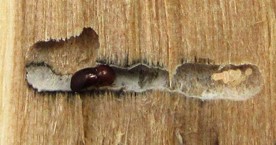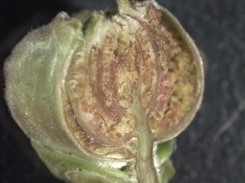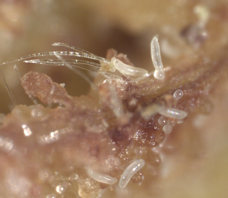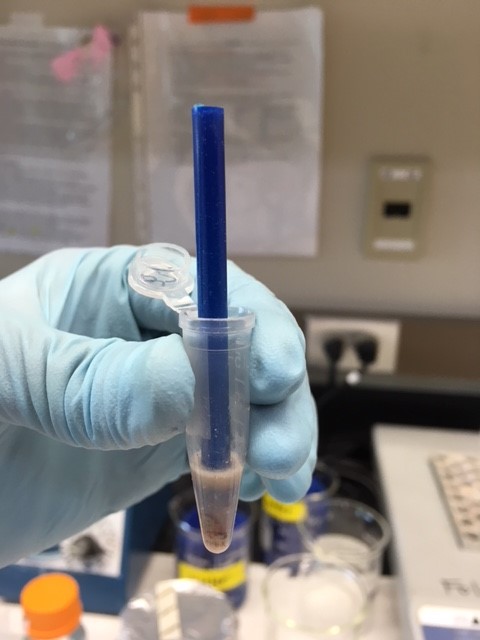Several arthropod pests feed on hazelnut foliage and damage nuts. Our lab is studying management options for several of these pests.
Jump to pests
Aphids
Aphids can be problematic for some hazelnut growers, particularly early in the spring before many natural enemies are present, but after leaves are budding out. Poor nut fill may result from nutrients and carbohydrates being depleted in leaves supporting nut development, and extremely high aphid pressure can lead to sooty mold (black fungus that forms a film over leaves and nuts), and reduced photosynthesis. Myzocallis coryli, the filbert aphid, was the only aphid species found in Oregon hazelnuts when action thresholds (the point at which growers need to manage a pest) were first developed. Since then, Crylobium avellanae, the hazelnut aphid, has established throughout the Willamette Valley. This species is often found on husks, and likely has more of an impact on nut quality. This year we are beginning to work on reevaluating the action thresholds, and are also testing management strategies, which include early season applications of oils that may control aphids while being softer on natural enemies. We will also look at the natural enemy complex that exists in hazelnut orchards, as beneficial predators are known to help control aphids, particularly later in the season.

Hazelnut aphids 
Filbert aphids

Syrphid fly larva 
Adult Trioxys pallidus wasp 
Hazelnut aphids, and an aphid mummy
Borers
Pacific flatheaded borer (Chrysobothris mali) is a beetle that damages stressed young trees. Borer damage can be avoided by reducing plant stress through adequate irrigation, preventing sunburn by painting trunks with a 50/50 mixture of white latex paint and water. Maintaining balanced nutrient levels is also key to healthy trees.
Shot hole borers are small black beetles, which bore into trees and create multiple galleries radiating out from the center of the trunk.
Ambrosia beetles cause damage by inoculating trees with a fungus, which adult beetles maintain for feeding their developing offspring. The beetles can persist in the trees for multiple generations. The lab is currently studying development of Pacific flatheaded borer, emergence from overwintering sites, and insecticide management options for combating these pests and increasing tree longevity. We have found that imidacloprid drenches, sprays and soaks (unregistered) prior to planting provide excellent control of PFB. Clothianidin (Belay), and also some diamide insecticides work well combating PFB. Please refer to the OSU Hazelnut Pest Management Guide for the Willamette Valley for a complete list of registered products.

Ambrosia beetle 
Adult Pacific flatheaded borer
Bud mites
These tiny eriophyid mites feed on catkins and developing floral and leaf buds. After swelling, the buds dry out and fall from the tree. Since most of the mite’s life cycle is spent protected within developing buds, they are difficult to manage.

Cross section of a blasted bud 
Bud mites
It is critical for chemical management to coincide with the migration of bud mites in spring, usually between March and May. This is when bud mites are most vulnerable to sprays because they are no longer protected by the bud exterior. It appears that peak migration occurs when maximum temperatures are above 59 F or average temperatures hover around 48 F, and are part of a long term warming trend. Through our research we have found that it is best to time sprays to when approximately 50% of the mites have emerged from the bud, and are making their way towards a fresh bud. Mites can also be monitored using double sided tape placed immediately below blasted buds. These must be checked frequently.
We have collected a large amount of data over the past three years, and are planning to generate a model that will allow growers to accurately estimate emergence based on weather data in their area, thus avoiding the use of tedious tape traps or counting bud mites on buds. There are several products that can be applied to control bud mites in Oregon, and these can be found in the OSU Hazelnut Pest Management Guide.
Filbertworm

Filbertworm (FBW), (Cydia latiferreana) a moth native to North America, is especially challenging to manage. This insect overwinters as a larva in leaf debris. Adults emerge from late May – October and lay eggs singly near maturing nuts. After hatching, the larvae bore into acorns and hazelnuts.
Signs of Filbertworm damage

Feeding trail left by immature FBW 
Interior feeding damage of FBW
Study of chemical efficacy
Reliance on a single mode of action and making repeated applications greatly increases the likelihood for resistance to develop. Organic hazelnut growers depend heavily on spinosad (Entrust) to control this pest because it is one of the few OMRI-listed insecticides available that works. Loss of efficacy would be devastating for Oregon’s organic industry. Growers are also limited in the total amount of a product that can be applied in a single year, and if there is only a single product (e.g. Entrust) that is effective, the maximum allowed usage (3 applications) is easily reached before the end of the season, leaving growers with no alternatives for controlling the pest. Spinosad is also very costly, and finding alternatives that are more cost effective could help expand the organic hazelnut industry. Therefore, it is essential to evaluate current FBW control strategies and find new solutions to control this pest.
While pheromone-based mating disruption is available to growers, this technique only works when the adult population is already reduced to a manageable level. This is not the case for a majority of organic growers. Most growers also control moths culturally by flailing nuts that drop from the trees early. But it is still extremely difficult for organic growers to manage FBW to the same damage tolerance levels (1% damage) as conventional growers and have their nuts accepted at a processor.
Since 2017 we have tested a myriad of products (including several organic products) for efficacy against FBW, and have found a number of very promising candidates- some of which are already registered for use on hazelnuts, and some we are pursuing registrations for. Eventually we plan to develop an entire management strategy, which will include information on monitoring for FBW, and will explain both chemical and cultural control options.
Study of Filbertworm movement
Growers who have high FBW pressure in their orchards may become concerned that FBW are feeding on acorns as larvae, and then migrating into their orchards as adults. Since FBW feed on additional nut species including oaks, prophylactic insecticide treatments to oak trees surrounding their hazelnut orchards may prevent FBW migration into the orchards. Yet, there is scant evidence to support this management recommendation. In 2017 we began looking for differences in the fatty acids of FBW that have been fed acorn or hazelnut diets as larvae. We found that they do have distinct lipid profiles based on host, and last year we began phase two of the trial- collecting FBW in traps in hazelnuts and oaks. The collected adults still need to be analyzed, and we will pursue this same objective during the summer of 2020.
If the FBW captured in hazelnut orchards contain lipids unique to FBW raised on acorns, that will indicate adult FBW are migrating into the orchard from oaks. If this is the case, rather than spraying giant oak trees with insecticides, it could be helpful to hang additional monitoring traps along the edge of the orchard and apply border sprays to the hazelnuts when trap catches hit thresholds, to target incoming moths. Oak trees are fabulous habitat for roosting raptor birds, which eat rodents that get into orchards, and oaks provide food for all sorts of animals, such as wild turkeys, so it is beneficial to avoid damaging oaks.

Preparing samples for GC 
Gas chromatography machine 
Trays of nuts infested with FBW

